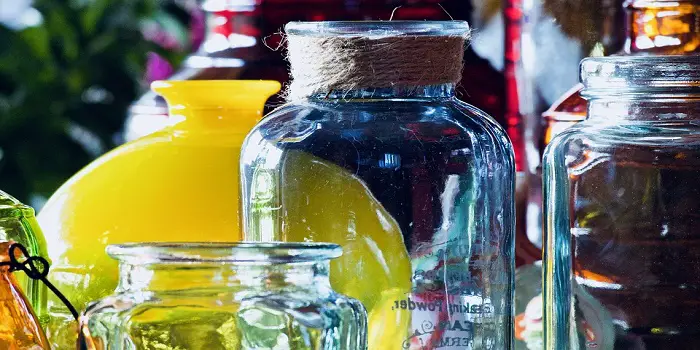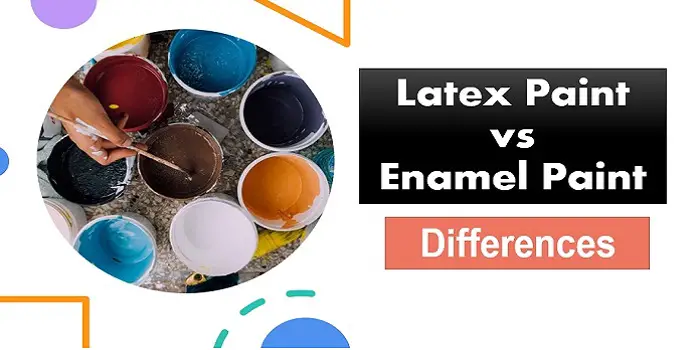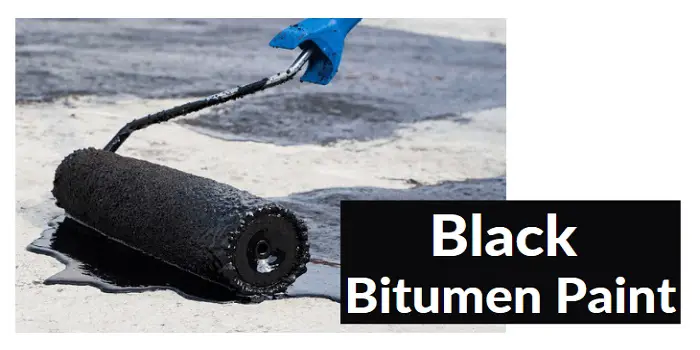
You may know bitumen from its other name, asphalt.
This sticky, highly viscous liquid is best described as a syrupy form of petroleum.
Bitumen comes from the residue created by the distillation of petroleum and is most often used for roofing and surfacing roads.
It’s inexpensive, durable, and flexible, thanks to its semi-solid nature.
It can also stop rust from forming, which is another positive attribute when used on metal surfaces.
Because of its many attributes, which include resistance to ultraviolet or UV light, harsh chemicals, and water which makes it an excellent waterproofing material, bitumen is also used as a practical, low-cost paint that can be used to protect a wide variety of surfaces.
What's Here in the Article:
What is Bitumen Paint?
Bitumen paint is a protective coating made from refined bitumen, a hydrocarbon material derived from crude oil.
It’s dissolved or blended with organic solvents to create a liquid form that can be easily applied to metal, concrete, wood, or masonry surfaces.
Once the solvent evaporates, it leaves behind a dense, waterproof, and glossy black film.
The paint primarily contains bitumen (as the base binder), mineral fillers for thickness and coverage, and solvents such as white spirit or naphtha to maintain the desired viscosity.
Some formulations may also include small amounts of drying agents, plasticizers, or resins to improve flexibility, adhesion, and durability.
Because of its dense, tar-like composition, black bitumen paint provides a strong barrier against moisture, air, and chemical vapors, making it ideal for environments where protection from corrosion or dampness is crucial—even though its use and applications are discussed separately.
Is Bitumen Paint Essentially Black?
Yes — bitumen paint is essentially black in color.
That deep black hue comes naturally from bitumen itself, which is a dark, viscous form of petroleum.
Since the paint’s main ingredient is refined bitumen, the resulting coating inherits its color—rich black with a glossy or semi-gloss finish once dried.
While manufacturers can slightly alter its tone or sheen by adding fillers or resins, true bitumen paint remains characteristically black, not tinted or colored like conventional paints.
This dark color also contributes to its light-absorbing and weather-resistant qualities, which are part of what makes bitumen coatings so durable.
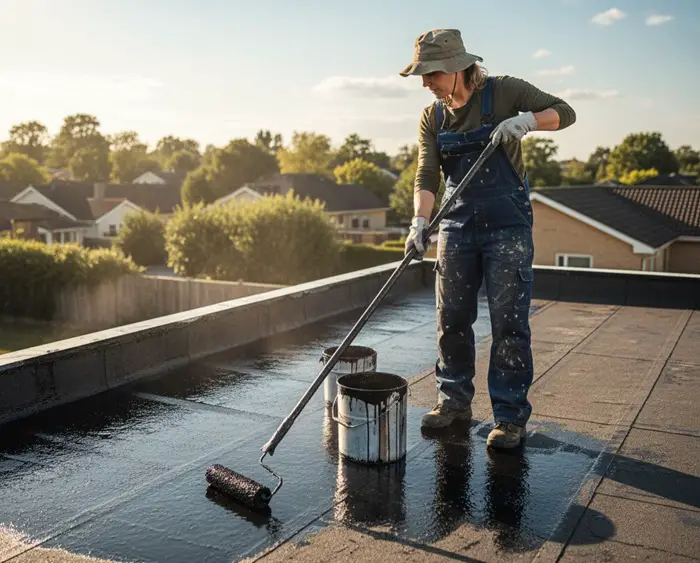
What is Black Bitumen Paint Used For?
Black bitumen paint (also known as bituminous paint or bituminous coating) is that dependable, no-nonsense layer of protection you give to surfaces you really don’t want water, rust, or weather messing with.
Think of it as a rugged raincoat for your roof, steel, or wooden boards — one that clings tightly and lasts for years.
Thanks to its strong adhesion and waterproof nature, it’s used across a variety of surfaces, from concrete to iron and even timber.
1. Roofing Protection
Bitumen paint and roofs go hand in hand — particularly flat or industrial roofs that take the brunt of weather. It forms a continuous waterproof layer, preventing leaks and UV damage.
Many professionals also use it as a quick fix to seal cracks or joints between roofing materials. It’s not glamorous work, but bitumen paint does it better than most.
2. Heavy-Duty Waterproofing
Below the surface, bitumen paint earns its keep in waterproofing foundations and retaining walls. Its hydrocarbon-rich barrier keeps moisture, salts, and chemicals at bay.
Once dry, it’s odorless and non-sticky — ideal for damp environments like basements and underground structures. Some even use it inside water tanks (though not potable ones).
3. Timber & Board Sealing
Wood, OSB, and sterling boards are porous and prone to moisture absorption — and bitumen paint is the perfect sealant to keep that in check.
It fills micro-gaps, giving the surface a smooth, waterproof skin. While it can’t stop a gushing leak on its own, when paired with a proper compound, it’s a reliable crack-sealer and preservative for wooden structures.
4. Performance in Humid Conditions
In climates where humidity and rain seem relentless (looking at you, UK and coastal tropics), bitumen paint shines.
It dries quickly, doesn’t flake easily, and maintains its sheen even in muggy conditions.
A quick note: if you plan to repaint over it, stick to another bituminous product — regular paints tend to “bleed” and show patches of black through.
5. Corrosion Resistance for Metals
Bitumen paint’s strong adhesion and chemical resistance make it an excellent protective coat for iron, steel, and machinery exposed to the elements.
It prevents rust formation by sealing the surface from oxygen and moisture.
Many industrial setups rely on it as a base or standalone layer on pipes, tanks, and structural frames — a simple yet effective armor against corrosion.
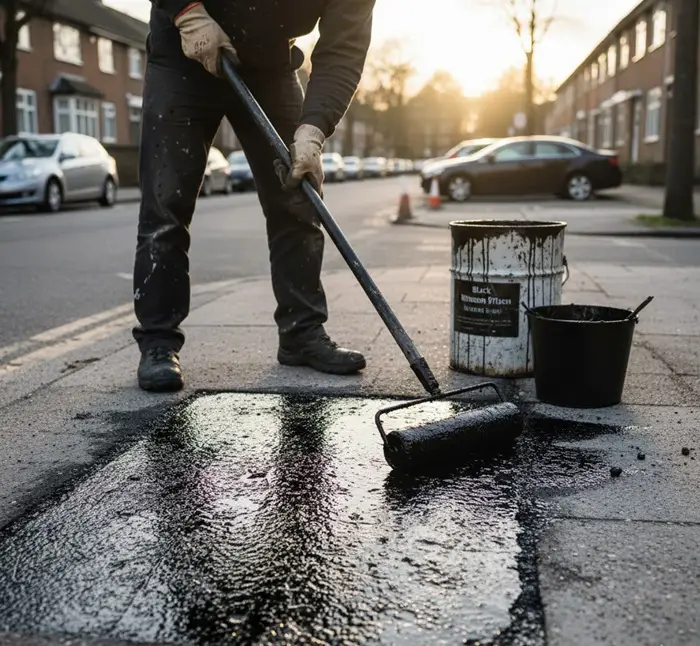
Advantages and Disadvantages of Bituminous Paint
Bitumen paint is one of those old-school, tried-and-true coatings that quietly outperforms its price tag. It doesn’t need to be fancy — it just gets the job done.
Whether you’re waterproofing a roof, coating a steel beam, or sealing a wooden board, black bituminous paint delivers a durable shield that’s both tough and economical.
But like every product with a long résumé, it comes with a few quirks worth knowing.
Pros of Bitumen Paint
1. Inexpensive yet Effective
Bitumen paint sits comfortably in the “budget-friendly but reliable” category.
It’s affordable, easy to find, and doesn’t require any special equipment to apply.
For DIYers and professionals alike, it’s a go-to coating that offers strong protection without burning a hole in the wallet.
2. Exceptionally Versatile
Few coatings can claim such a wide range of uses — metal, concrete, masonry, and wood all bond beautifully with bitumen.
Its adhesive nature ensures it grips to most surfaces, even those that other paints might reject. In short, it’s the coating world’s version of a multi-tool.
3. Weatherproof & Corrosion-Resistant
When it comes to keeping moisture and oxygen out, bitumen paint performs like a champ. Its dense, tar-like composition creates an impermeable barrier against rain, rust, and even mild chemicals.
This is why it’s often seen on exposed or industrial surfaces that face year-round weather punishment.
4. Quick Drying and Layer-Friendly
Bitumen paint dries faster than many traditional coatings, letting you build up multiple layers in a single day.
That means less downtime between coats and faster project completion — a huge bonus for professionals racing against the weather.
5. Durable and Low-Odor Once Dry
Once cured, it’s rock solid — resistant to cracking, peeling, or flaking.
And unlike some industrial coatings, it doesn’t leave behind a harsh odor, making it usable in semi-enclosed areas where ventilation is limited.
Cons of Bitumen Paint
1. Limited Application Aesthetics
Let’s face it — it’s black, and that’s about it. If your design vision involves color, bitumen paint won’t win you over. It’s a functional coating, not a decorative one.
2. Not Ideal for Indoor Walls
Although it can technically be used indoors, bitumen paint isn’t meant for decorative wall finishes.
Its glossy black appearance and heavy texture make it better suited for protective purposes rather than visual appeal.
3. Sensitive to Temperature Extremes
High heat and humidity can cause bitumen coatings to fade or soften over time, while extremely cold weather can make application tricky. It prefers mild to moderate climates for best performance.
4. Bleed-Through Issues
Painting over bitumen with regular paint is a common rookie mistake.
The dark pigment tends to “bleed” through lighter topcoats, spoiling the finish. The rule is simple: stick with bitumen on bitumen.
5. Not a Structural Fix
It seals, it shields, but it doesn’t repair. Bitumen paint can cover hairline cracks and minor surface flaws, but it won’t fix deeper structural problems or leaks without proper fillers or compounds.
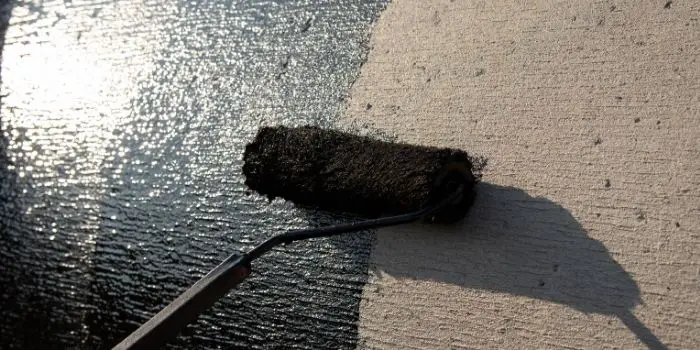
How to Apply Black Bituminous Paint for Maximum Protection?
Before you even dip that brush into bitumen paint, a quick safety check is non-negotiable.
This isn’t your everyday wall paint — it’s a solvent-based coating, which means it demands a little respect and precaution.
Start by protecting your skin and eyes with gloves, long sleeves, and safety goggles.
Bitumen has a sneaky way of sticking to everything it touches (including you), and it’s not easy to remove once it dries. A good pair of nitrile gloves will save you a lot of scrubbing later.
If you’re working indoors or in enclosed spaces, ensure proper ventilation — open windows, use exhaust fans, or set up cross-flow air movement.
The solvent fumes can be strong and uncomfortable, so a well-aerated area keeps things breathable and safe.
Also, be aware of your surroundings. Bitumen paint and open flames are sworn enemies — so keep it far from hot surfaces, sparks, pilot lights, or welding zones.
The solvent vapors are flammable, and you don’t want to find that out the hard way.
Step 1- Clean the surface
The better you prepare the surface, the easier it will be to apply the bitumen paint.
You should start by cleaning the surface of all debris, grease, rust, and the like. Be sure the surface is fully cleaned and dried before you apply the first coat.
To apply bitumen paint to metal surfaces, use a wire brush to remove any rust first.
You can also use other methods such as shot blasting or a mechanical device, but the surface must be rust-free.
Step 2- Apply thinner
For surfaces that have been galvanized, rough it up with an etch primer or wire brush so the paint will stick.
Then, before applying the bitumen paint, cover with an anti-corrosive primer first for maximum protection.
Once your surface is ready, apply the paint within the next few hours for maximum results.
Step 3- Apply the bitumen paint
If the surface you are applying the paint on is porous in nature, thin the bitumen paint by 20% or so, which will help it penetrate and protect the top of the material.
You can use different methods to apply the paint, including conventional, airless, or hot spray. Or you can use a brush.
Whichever method you use, you should add a top coat of more bitumen paint 24 hours have passed.
You can expect the bitumen paint to dry within four hours or less under most conditions.
Once dry, add a second coat for maximum effect and check the results.
You can expect the paint to last for several years under ideal conditions.
However, as a roofing paint, it may dry out within 2 to 3 years and need touching up to prevent cracking.
A protective coat of solar reflective bitumen aluminum paint is also sometimes recommended for extra durability.
Can Bitumen Paint Be Applied in Cold Weather? Factors To Consider Before Applying
Bitumen paint can be used in cold weather, but success depends on maintaining dry surfaces, suitable temperature, and extended drying times. Planning and preparation are key to preventing common issues like peeling, cracking, or uneven coating.
Cold conditions can actually affect the bitumen paint’s consistency, drying time, and final performance. So, here’s a detailed breakdown:
1. Temperature Guidelines
Bitumen paint has an optimal application range, usually between 10°C and 35°C.
Applying it below the minimum recommended temperature can make the paint thicker and harder to spread, leading to uneven coating.
Extreme cold can also slow down curing, increasing the risk of dust, debris, or moisture sticking to the surface.
2. Surface Condition
In cold weather, surfaces may be frosty, damp, or frozen, which can prevent proper adhesion.
Ensure the surface is dry, clean, and free from frost before painting.
If there’s condensation or moisture, the paint may peel or fail to form a protective layer.
3. Extended Drying Time
Cold weather slows the evaporation of solvents in bitumen paint. This means drying and curing can take several hours longer than usual.
Plan your painting schedule to allow sufficient time for full curing before exposing the surface to rain, snow, or heavy use.
4. Application Method
In colder temperatures, the paint may thicken, so using a brush or roller with a wider nap can help achieve a smooth coat.
Sometimes, gentle warming of the paint container (not over 40°C) can improve flow and coverage.
5. Protective Measures
Cold weather may also bring wind or snow, which can settle on freshly applied paint. Consider covering the painted area with a tarp or temporary shelter until it fully dries.
FAQs
Does bitumen paint have a smell?
Yes, bitumen paint emits a strong, characteristic odor because of its chemical composition.
It’s best applied in well-ventilated areas, and using protective gear such as a mask and gloves can help reduce exposure to fumes. Once the paint dries completely, it forms a hard, odorless protective layer.
How can bitumen paint be removed?
Bitumen paint can be stubborn to remove, but it is possible with specialized solvents designed to dissolve it, such as tar removers.
Always follow the manufacturer’s instructions carefully and take precautions to protect the underlying surface from damage.
Which brands sell quality black bitumen paint?
For U.S. buyers looking for quality black bitumen paint, several trusted brands are available.
- Rust-Oleum is well-known for its durable coatings suitable for metal, concrete, and asphalt surfaces.
- Black Jack offers a range of asphalt and driveway sealers that provide excellent waterproofing and protection.
- Henry Company specializes in roofing and blacktop coatings, while Gardner is recognized for reliable asphalt sealers.
- CRL (C.R. Laurence) also provides bituminous coatings designed for protecting metal components in concrete structures.
Screwfix UK also offers several quality black bitumen and waterproofing paints suitable for various applications. You can pick Bostik 5Ltr or Isoflex 2.1Ltr.
These products are widely available through major retailers like Home Depot, Amazon, and local hardware stores. When choosing a bitumen paint, consider the surface type, environmental conditions, and desired durability to ensure the coating performs effectively.
Final Thoughts
Bituminous paint is a type of paint that is most often used for building surfaces made from common materials.
Because it dries fast and is resistant to water, alcohol, diluted acids, and salt solutions, it is often used for outdoor paint. Also, because it is inexpensive and widely available, it is considered an economical option.
Despite all its advantages, there are things you should look out for before purchasing bitumen paint. So, before you pick this as your paint, go through the advantages and disadvantages to know if it’s really a product you need.
Share the post "What is Black Bitumen Paint – What it is Used For?"

Douglas Becker (aka Painter Doug) has over twenty years of experience as a painter in Adkins, Texas. At present, he resides in Florida with his family.
From painting multi-storeyed houses, condos, and apartments to large commercial buildings and small offices, he had served various customers in areas not only in Adkins but also in Southwest Florida, Sarasota, Naples, and many more. To know more about him check here.

